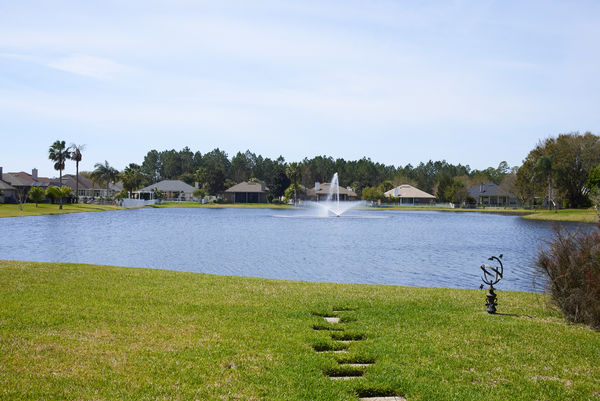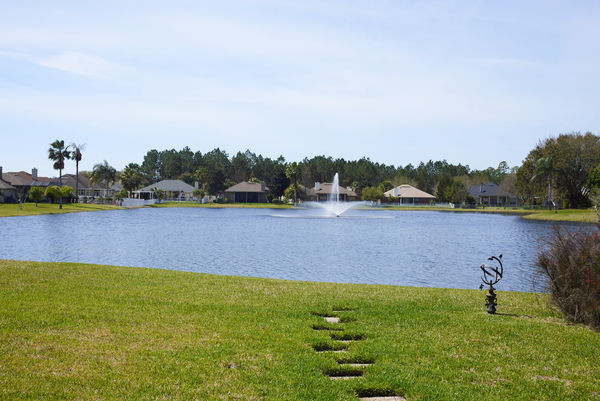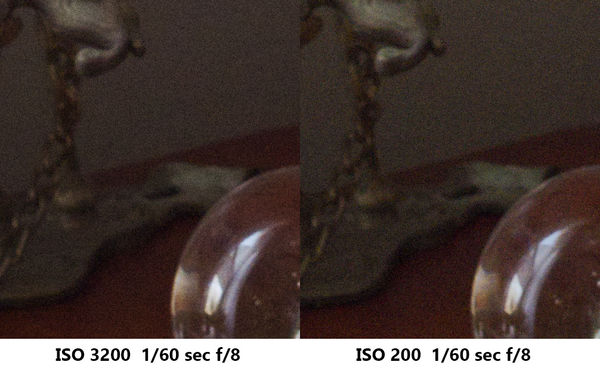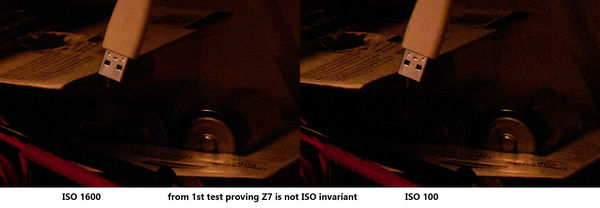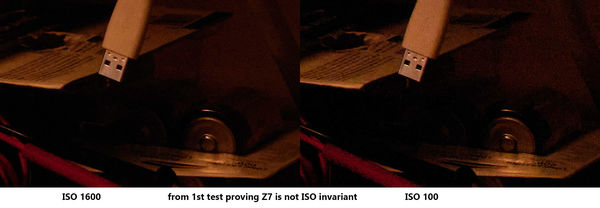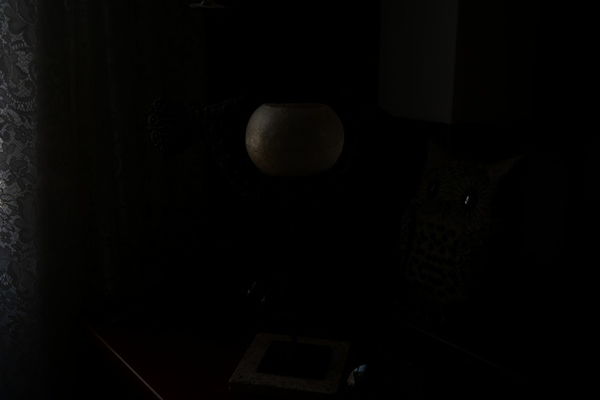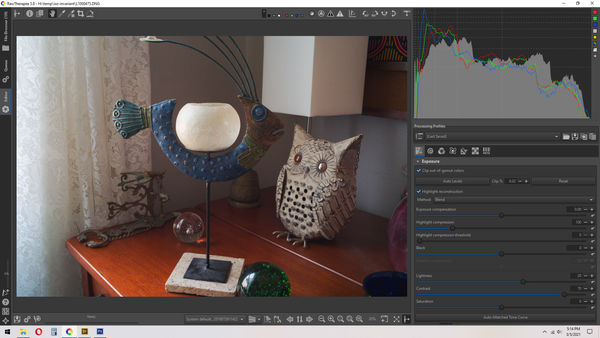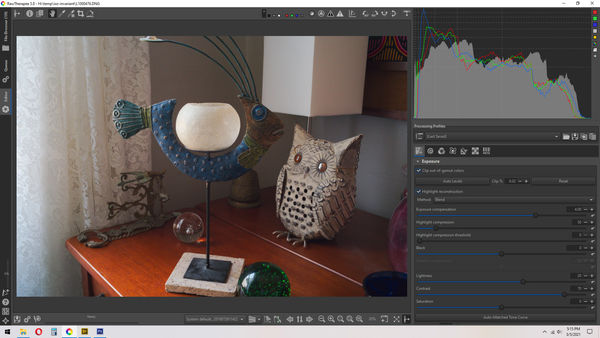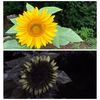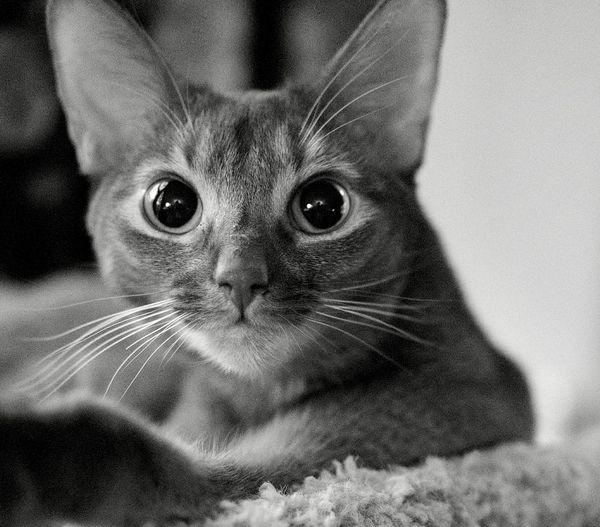Max ISO
Mar 5, 2021 14:59:35 #
Yet another test using the D610 and the same exposure settings. But this time I used a more normal scene, broad daylight and a DR of about 7 stops:

At ISO 1600 the exposure is not pushed all the way to the right. It doesn't need to be because the darkest part of the image is far from the left end of the display.
But when we lower the ISO to 100, all of the values become 1/16th of what they would have been with a normal exposure:

But now a substantial portion of the 24 MP image (6 MP, 25%) has pixels with a value of 0.
With only about 75% of the pixels left to work with, Capture One can still construct an image. But the missing information has an impact on the fidelity of the result. That's not noise. It's the effect of applying ISO invariance.
So for all intents and purposes, this experiment shows that the D610 is ISO invariant. But the use of invariance comes at a price. There is a serious potential for loss of information in the unexposed pixels and the image on the camera's LCD might be useless. In this case the LCD was almost black and the camera's histograms were bunched up against the left side of the plot.

At ISO 1600 the exposure is not pushed all the way to the right. It doesn't need to be because the darkest part of the image is far from the left end of the display.
But when we lower the ISO to 100, all of the values become 1/16th of what they would have been with a normal exposure:

But now a substantial portion of the 24 MP image (6 MP, 25%) has pixels with a value of 0.
With only about 75% of the pixels left to work with, Capture One can still construct an image. But the missing information has an impact on the fidelity of the result. That's not noise. It's the effect of applying ISO invariance.
So for all intents and purposes, this experiment shows that the D610 is ISO invariant. But the use of invariance comes at a price. There is a serious potential for loss of information in the unexposed pixels and the image on the camera's LCD might be useless. In this case the LCD was almost black and the camera's histograms were bunched up against the left side of the plot.
Mar 5, 2021 15:13:25 #
Ysarex
Loc: St. Louis
selmslie wrote:
That only proves that you don't have a clue what you are looking at. That's not noise. That's signal loss.
Oh no! When you don't change the exposure you lose signal!!! Pure smoke blowing BS on top of your lying. That's what ISO invariance is about right? Appling gain to the signal in camera is no better than scaling the signal in post.
Here's a valid test of ISO invariance unlike your invalid test. This camera (SL) also has a dual gain sensor but in the second channel it's pretty ISO invariant. I set the exposure for ISO 3200 and took the photo at that exposure for both ISO 3200 and ISO 200 -- 4 stop difference like you tested. ISO 200 is where the second gain channel switches in so I avoided straddling the two channels and invalidating the test like you.
I got dramatically better results than you did because I did the test correctly -- 100% crop below and your invalid test below for comparison. What we see in your test is the difference between the two gain channels. The Z7 is fairly ISO invariant in the second gain channel but if you want to conduct a 4 stop test you have to do that over the range ISO 400 to ISO 6400. And frankly I believe you knew that right from the start.
Full res versions:
https://www.dropbox.com/s/9pp6ixeujajbsze/iso-3200.jpg?dl=0
https://www.dropbox.com/s/1q1nr7yu60ly8e5/iso-200.jpg?dl=0
Mar 5, 2021 16:01:45 #
Ysarex wrote:
Oh no! When you don't change the exposure you lose signal!!! Pure smoke blowing BS on top of your lying. That's what ISO invariance is about right? Appling gain to the signal in camera is no better than scaling the signal in post. ....
That's clear evidence that you don't understand what's going on.
When you lower the ISO all three raw histograms move the left. They are plotted on a log scale. Something that would have recorded 3 stops from the minimum recorded value at ISO 1600 is now recorded with a binary value of 0 at ISO 100.
Here is some information from one of my Z7 tests on a scene with a wide DR:
ISO # of 0 values
6400 11 MP
3200 16 MP
1600 25 MP
800 30 MP
400 34 MP
200 38 MP
100 41 MP
Where do you suppose all of those 0 values came from? The way you view it none of them should be 0.

Depending on the exposure and the scene's DR you can actually lose most or all of the shadow information. And if a lot of adjacent raw pixels have a value of 0 the result will be pure black. No matter how far you move the Exposure slider 0 will remain 0. That area will be pure black with no noise.
You really have no clue about the mathematics involved in an A/D conversion. It involves logarithms. Did you not study logarithms in school? It doesn't look like you are qualified to discuss this topic.
Mar 5, 2021 16:16:38 #
Ysarex wrote:
Oh no! When you don't change the exposure you lose... (show quote)
Joe, any chance you might be able to post histograms of your two shots? I don’t need RawDigger, I’d just be interested in seeing the histogram from your PP ap.
Thanks.
Mar 5, 2021 17:16:50 #
The D610 is apparently ISO invariant and the test images are almost indistinguishable other than some blown highlights in the first two.

Here is some information from the D610 test tests on a scene with a normal DR. It is from the information reported by RawDigger. It comes from the binary raw values that the camera wrote to the raw file and it is independent of anything that might happen in the raw conversion process on our computer.
ISO # of 0 values
6400 138
3200 853
1600 164k
800 132k
400 773k
200 2.8 MP
100 6 MP
Where do you suppose all of those 0 values came from?
I can't explain the apparent outlier at ISO 800. There is no apparent reason for that in the Photons to Photos plot. But I don't really care why it happened. It is what it is.

Here is some information from the D610 test tests on a scene with a normal DR. It is from the information reported by RawDigger. It comes from the binary raw values that the camera wrote to the raw file and it is independent of anything that might happen in the raw conversion process on our computer.
ISO # of 0 values
6400 138
3200 853
1600 164k
800 132k
400 773k
200 2.8 MP
100 6 MP
Where do you suppose all of those 0 values came from?
I can't explain the apparent outlier at ISO 800. There is no apparent reason for that in the Photons to Photos plot. But I don't really care why it happened. It is what it is.
Mar 5, 2021 18:58:29 #
Ysarex
Loc: St. Louis
selmslie wrote:
That's clear evidence that you don't understand what's going on.
What's clear is your sophist RDiggery smoke blowing BS is well over waist deep.
The exposure is the signal. The same exposure is the same signal. Are you claiming now that ISO gain applied in camera to the signal creates and inserts new data that wasn't there when the shutter closed?
Why is it that when I conducted a valid test for ISO invariance I didn't experience the same signal loss that you claim you did when you conducted your test incorrectly? If you try and claim the scene I shot didn't have enough DR you'll be raising the BS level to shoulder depth.
Here's a comment from someone who also knows you're full of BS: "Some modern Sony sensors have what is called dual gain, means they actually have two ISO invariance points, my Nikon Z7 for instance is ISO invariant from ISO 64 to 350 and then invariant from ISO 400 up to the maximum ISO. Consulting Bill Claff’s website is the easiest way to find your camera’s invariance point if it has one." [my bold] https://www.utahastrophotography.com/Astrophotography-101-Cameras
And here's a comment by Thom Hogan that confirms what you did was an invalid test: "What dual gain does is reset that curve because it lowers the noise being introduced at the gain stage. So, for instance, the Fujifilm X-Pro2 seems to have the same dynamic range at ISO 800 as it does at 600 instead of an expected loss of about a third of a stop. From ISO 800, the slope of dynamic range loss resumes at the expected near one stop per ISO stop rate. The net effect, therefore, is that the high ISO values have about a third of a stop more useful dynamic range than they would have under the old single gain system." https://www.sansmirror.com/newsviews/2016-newsview/jan-mar-2016-newsviews-2/dual-gain-becoming-the-norm.html
You have any references? How many pages of your BS and still no references of any kind.....
Your test was invalid. The Z7 has a dual gain sensor and you tried to test for ISO invariance using an ISO range that included the point where the dual gain switch occurs. Read Thom Hogan's comment above to understand why you're full of it.
Here again is your proof that you're full of it. It shows the difference that the dual gain switch generates not either success or failure of ISO invariance.
Mar 5, 2021 19:06:10 #
Marv Whealon
Loc: Southwest Quebec Canada
I set my Nikon d7500 at iso maxed at 6400 for low light conditions photographing wildlife. I then denoise in Lightroom.
Mar 5, 2021 19:09:33 #
Ysarex
Loc: St. Louis
TriX wrote:
Joe, any chance you might be able to post histograms of your two shots? I don’t need RawDigger, I’d just be interested in seeing the histogram from your PP ap.
Thanks.
Thanks.
Sure. Here's a couple things for illustration.
First image below is camera JPEG metered for and shot at ISO 3200.
Second image is camera JPEG same exposure as ISO 3200 shot but with the ISO dropped to 200.
I used Raw Therapee to do the processing. I like it for this kind of comparison because it lets you turn more crap off than the commercial apps.
Both raw files are processed identically with two differences. You can see the exposure slider difference in the screen shots and that'll tell you which one is which -- + 4 for the ISO 200 shot. The other difference is that I applied less highlight compression for the ISO 200 shot as it didn't need it.
And here's the two final images from RT for reference -- reasonably ISO invariant. A touch of noise filtering and there's no visible difference.
https://www.dropbox.com/s/9pp6ixeujajbsze/iso-3200.jpg?dl=0
https://www.dropbox.com/s/1q1nr7yu60ly8e5/iso-200.jpg?dl=0
Mar 5, 2021 19:52:21 #
Ysarex wrote:
Sure. Here's a couple things for illustration. br ... (show quote)
Thanks Joe. The reason I wanted to see the histogram was that in one of the past tests of ISO invariance, the histograms were different (in the distribution of colors, not just the position on the axis).
Mar 5, 2021 20:05:28 #
Ysarex wrote:
What's clear is your sophist RDiggery smoke blowin... (show quote)
You don't have a clue how a raw file gets converted to an image.
If the brightest part of the image gets converted to a raw bit value that's only about 1000 at ISO 100, how do you get it to a value of 16000? By multiplying each value by 16.
That means that each value from 0 through 1000 (0. 1, 2, 3, 4, 5, ... 1000) is now 16x larger (0, 16, 32, 48, 64, 80, ... 16000). Where do the values between them come from? They are invented by the demosaicing process if you use a Bayer array. If no Bayer array they simply remain separated by 16.
The resulting data then gets a logarithmic conversion to make the JPEG fit within the desired range of 0-255.
Your lack of understanding about this process is astounding. The concepts are over your head.
Mar 5, 2021 20:14:52 #
Ysarex
Loc: St. Louis
TriX wrote:
Thanks Joe. The reason I wanted to see the histogram was that in one of the past tests of ISO invariance, the histograms were different (in the distribution of colors, not just the position on the axis).
These are slightly different and there are always some color differences across a four or more stop range. I used to own what was considered one of the most ISO invariant cameras when I had a Fuji with the X-Trans II sensor. I had a few occasions to take advantage of that but for the most part it's pretty esoteric -- not a feature. I've never seen a camera that is truly ISO invariant but more and more of them are coming closer and closer. Close enough to use if there was a need. New twist however is dual gain. Four of my five cameras are now dual gain. I like it! But those cameras are not invariant across that gain switch. They can't be -- engaging the second gain channel alters the sensor DR -- it moves the noise floor. And contrary to our resident RDiggery sophist ISO invariance is largely about noise. The SL that I used here is paradoxically the most invariant in the high ISO channel but horribly not invariant across that gain switch. It's real important to not underexpose that sensor at ISOs below 200.
Mar 5, 2021 20:21:42 #
Ysarex
Loc: St. Louis
selmslie wrote:
You don't have a clue how a raw file gets converted to an image.
Oh please help me! Answer my question that you ignored: "Why is it that when I conducted a valid test for ISO invariance I didn't experience the same signal loss that you claim you did when you conducted your test incorrectly?"
I know this: The exposure is the signal. The same exposure is the same signal. Neither analog gain nor digital scaling adds any new data.
And I know you're blowing more BS smoke.
Answer my question. In my last post I provide a reference that proved you're full of it. You're proven wrong. Where's your counter reference? I'll wait.....
Mar 5, 2021 20:38:08 #
joecichjr wrote:
Politely, I don’t know why you were under that [your former] impression either. Since humans cannot perceive UV or IR, why would there be any expectation of color? I don't know why I was under the impression that UV revealed a world of very many colors that we can't see with the naked eye...It looks a little drab compared to real-world colors. Just surprised is all.
The only explanations I can come up with are that you’ve previously been looking at post-processed images OR those that included some portion of the visible light spectrum.
My photos are SOOC (Straight Out Of the Camera). The only editing I currently do is cropping or with respect to image brightness and/or contrast.
But I do thank you for noting my post. I guess I should have added that my photos are handheld, so the ISO settings I employed are generally the minimum for walk-in around and shooting in the UV-A band.
Here’s an example of the other color that I’ve observed in my UV-A photos SOOC: Purple!
(For comparison is provided a visible light-only photograph taken within minutes of the other.)
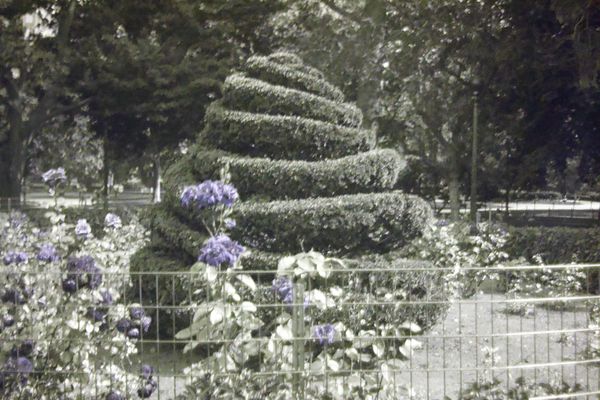

Mar 5, 2021 21:53:07 #
>Sometimes a little noise is better than not getting any shot....
And you're in a lot of situations where 3200 just ain't enuf? Or 1600? If it's too dark for 200, it's too dark for me! Harry
And you're in a lot of situations where 3200 just ain't enuf? Or 1600? If it's too dark for 200, it's too dark for me! Harry
Mar 5, 2021 22:35:36 #
hrblaine wrote:
>Sometimes a little noise is better than not getting any shot....
And you're in a lot of situations where 3200 just ain't enuf? Or 1600? If it's too dark for 200, it's too dark for me! Harry
And you're in a lot of situations where 3200 just ain't enuf? Or 1600? If it's too dark for 200, it's too dark for me! Harry
Then you can forget indoor shots of moving (ie living) subjects where flash is not practical.
For example, a recent wedding reception in a very well lighted venue required ISO 4,000 - 8,000 with a SS of 1/160 - 1/200 and aperture of f 2.0-2.8 for the proper exposure (and the inside of the church was substantially darker).
There’s no reason to be afraid of high ISOs with modern sensors. The shot below was taken with a crop Fuji camera in available fairly dim room light at ISO 6400 @f2. This is SOOC with no PP noise reduction. Is there noise in the shadows if you enlarge the image and pixel peep? Certainly, but I don’t find it noticeable or objectionable at a normal size and viewing distance, and I could have done the same at 12,800 @f2.8 with my FF Canon. If I had used aggressive noise reduction in PP with a raw file, I could have improved it more.
If you want to reply, then register here. Registration is free and your account is created instantly, so you can post right away.

